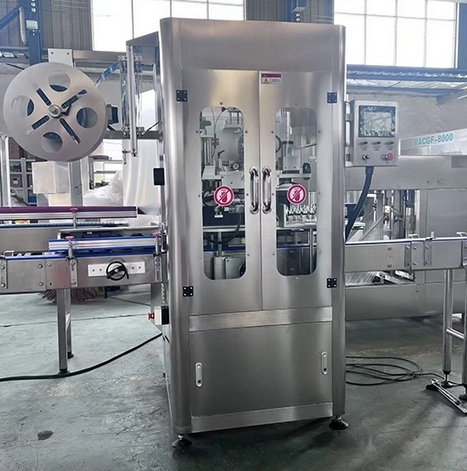Container Conveying Link: Firstly, the containers to be labeled, such as bottles and jars, are placed on the conveyor belt. The conveyor belt runs at a stable and adjustable speed to ensure that the containers can enter each working area of the labeling machine one by one and smoothly. This conveying process is the starting foundation of the entire workflow. The accurate and uniform conveying of the containers is crucial for the precision of the subsequent labeling steps.
Label Feeding Part: The shrink sleeve labeling machine is equipped with a special label unwinding device, and the labels are usually installed on it in a roll form. As the equipment operates, the label roll will unwind slowly and smoothly, conveying the labels to the designated position. During the conveying process, there will be a tension control system that monitors and adjusts the conveying tension of the labels in real time to prevent the labels from being loose or too tight, so as to ensure that the labels can enter the next process smoothly and accurately.
Labeling Operation Process: When the container is conveyed to the labeling position, the label will be accurately placed on the container through a specific mechanical structure. There are two common labeling methods: one is to use the principle of vacuum adsorption. Through a sleeve or drum with vacuum holes, the label is adsorbed on its surface. When the container approaches, the vacuum is released, and the label is then placed on the container. The other is the mechanical labeling method. Through a robotic arm or a similar structure, the label is cut to an appropriate length from the label roll and then directly placed on the container. This step requires a high degree of mechanical precision and timing coordination to ensure that the label is placed in the correct position without any error.
Shrink Forming Stage: The container with the label on it will then enter the shrinking area, which is usually a heating tunnel. In the heating tunnel, uniform and controllable hot air will be generated, or other heating methods such as infrared heating will be used. When the container passes through the heating tunnel with the label on it, the label material (usually heat-shrinkable plastics such as PVC and PETG) will quickly shrink under the action of heat and tightly fit the surface of the container, forming a tight wrapping effect that conforms to the shape of the container. Parameters such as the heating temperature, time, and the conveying speed of the container in the tunnel can all be precisely adjusted according to the label material and the container specifications to achieve the best shrinking effect.

